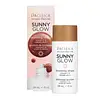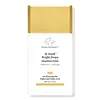What's inside
What's inside
 Key Ingredients
Key Ingredients

 Benefits
Benefits

 Concerns
Concerns

 Ingredients Side-by-side
Ingredients Side-by-side

Water
Skin ConditioningHydrogenated Polyisobutene
EmollientGlycerin
HumectantGlyceryl Oleate Citrate
EmulsifyingMica
Cosmetic ColorantHydroxyethyl Acrylate/Sodium Acryloyldimethyl Taurate Copolymer
Emulsion StabilisingCoco-Caprylate/Caprate
EmollientCaprylic/Capric Triglyceride
MaskingSilica
AbrasiveSodium Benzoate
MaskingSorbitan Isostearate
EmulsifyingGalactoarabinan
Sodium Ascorbyl Phosphate
AntioxidantTerminalia Ferdinandiana Fruit Extract
AntioxidantGlycolic Acid
BufferingTocopherol
AntioxidantPhenoxyethanol
PreservativeEthylhexylglycerin
Skin ConditioningLimonene
PerfumingBenzyl Alcohol
PerfumingParfum
MaskingIron Oxides
Water, Hydrogenated Polyisobutene, Glycerin, Glyceryl Oleate Citrate, Mica, Hydroxyethyl Acrylate/Sodium Acryloyldimethyl Taurate Copolymer, Coco-Caprylate/Caprate, Caprylic/Capric Triglyceride, Silica, Sodium Benzoate, Sorbitan Isostearate, Galactoarabinan, Sodium Ascorbyl Phosphate, Terminalia Ferdinandiana Fruit Extract, Glycolic Acid, Tocopherol, Phenoxyethanol, Ethylhexylglycerin, Limonene, Benzyl Alcohol, Parfum, Iron Oxides
Water
Skin ConditioningGlycerin
HumectantButylene Glycol
HumectantNiacinamide
SmoothingPropanediol
SolventNeopentyl Glycol Diheptanoate
EmollientMica
Cosmetic ColorantEthylhexyl Olivate
Skin ConditioningC9-12 Alkane
SolventCoco-Caprylate/Caprate
EmollientSclerocarya Birrea Seed Oil
HumectantCetearyl Alcohol
EmollientSimmondsia Chinensis Seed Oil
EmollientDiglucosyl Gallic Acid
Squalane
EmollientSorbitan Sesquiisostearate
EmulsifyingPlukenetia Volubilis Seed Oil
EmollientMorus Alba Leaf Extract
Skin ConditioningCalcium Chloride
AstringentSea Salt
AbrasiveSodium Stearate
CleansingHydroxyethyl Acrylate/Sodium Acryloyldimethyl Taurate Copolymer
Emulsion StabilisingTocopheryl Acetate
AntioxidantQuercetin
AntioxidantPPG-8-Ceteth-20
EmulsifyingSodium Carrageenan
Emulsion StabilisingGlyceryl Acrylate/Acrylic Acid Copolymer
HumectantXanthan Gum
EmulsifyingPhenoxyethanol
PreservativeSodium Metabisulfite
AntioxidantUbiquinone
AntioxidantAcrylates/Beheneth-25 Methacrylate Copolymer
C12-15 Alkyl Benzoate
AntimicrobialCitric Acid
BufferingTetrasodium Glutamate Diacetate
Sodium Citrate
BufferingCeteareth-20
CleansingDipropylene Glycol
HumectantTocopherol
AntioxidantSorbitan Isostearate
EmulsifyingPolysorbate 60
EmulsifyingSodium Hydroxide
BufferingSorbeth-30 Tetraisostearate
EmulsifyingCI 77491
Cosmetic ColorantCI 77492
Cosmetic ColorantCI 77891
Cosmetic ColorantWater, Glycerin, Butylene Glycol, Niacinamide, Propanediol, Neopentyl Glycol Diheptanoate, Mica, Ethylhexyl Olivate, C9-12 Alkane, Coco-Caprylate/Caprate, Sclerocarya Birrea Seed Oil, Cetearyl Alcohol, Simmondsia Chinensis Seed Oil, Diglucosyl Gallic Acid, Squalane, Sorbitan Sesquiisostearate, Plukenetia Volubilis Seed Oil, Morus Alba Leaf Extract, Calcium Chloride, Sea Salt, Sodium Stearate, Hydroxyethyl Acrylate/Sodium Acryloyldimethyl Taurate Copolymer, Tocopheryl Acetate, Quercetin, PPG-8-Ceteth-20, Sodium Carrageenan, Glyceryl Acrylate/Acrylic Acid Copolymer, Xanthan Gum, Phenoxyethanol, Sodium Metabisulfite, Ubiquinone, Acrylates/Beheneth-25 Methacrylate Copolymer, C12-15 Alkyl Benzoate, Citric Acid, Tetrasodium Glutamate Diacetate, Sodium Citrate, Ceteareth-20, Dipropylene Glycol, Tocopherol, Sorbitan Isostearate, Polysorbate 60, Sodium Hydroxide, Sorbeth-30 Tetraisostearate, CI 77491, CI 77492, CI 77891
Ingredients Explained
These ingredients are found in both products.
Ingredients higher up in an ingredient list are typically present in a larger amount.
Coco-Caprylate/Caprate is created from fatty coconut alcohol, caprylic acid, and capric acid.
It is a lightweight emollient. Emollients create a thin barrier on the skin to trap moisture in. This helps keep your skin hydrated and soft.
Once applied, Coco-Caprylate/Caprate is absorbed quickly and leaves a silky feel.
Coco-Caprylate/Caprate may not be fungal acne safe.
Learn more about Coco-Caprylate/CaprateGlycerin is already naturally found in your skin. It helps moisturize and protect your skin.
A study from 2016 found glycerin to be more effective as a humectant than AHAs and hyaluronic acid.
As a humectant, it helps the skin stay hydrated by pulling moisture to your skin. The low molecular weight of glycerin allows it to pull moisture into the deeper layers of your skin.
Hydrated skin improves your skin barrier; Your skin barrier helps protect against irritants and bacteria.
Glycerin has also been found to have antimicrobial and antiviral properties. Due to these properties, glycerin is often used in wound and burn treatments.
In cosmetics, glycerin is usually derived from plants such as soybean or palm. However, it can also be sourced from animals, such as tallow or animal fat.
This ingredient is organic, colorless, odorless, and non-toxic.
Glycerin is the name for this ingredient in American English. British English uses Glycerol/Glycerine.
Learn more about GlycerinThis is a synthetic polymer. It helps improve the texture of products by adding thickness and gel-like feel.
It is also an emulsifer, meaning it prevents ingredients such as oil and water from separating. It also helps evenly disperse other ingredients.
Mica is a naturally occurring mineral used to add shimmer and color in cosmetics. It can also help improve the texture of a product or give it an opaque, white/silver color.
Serecite is the name for very fine but ragged grains of mica.
This ingredient is often coated with metal oxides like titanium dioxide. Trace amounts of heavy metals may be found in mica, but these metals are not harmful in our personal products.
Mica has been used since prehistoric times throughout the world. Ancient Egyptian, Indian, Greek, Roman, Aztec, and Chinese civilizations have used mica.
Learn more about MicaPhenoxyethanol is a preservative that has germicide, antimicrobial, and aromatic properties. Studies show that phenoxyethanol can prevent microbial growth. By itself, it has a scent that is similar to that of a rose.
It's often used in formulations along with Caprylyl Glycol to preserve the shelf life of products.
Sorbitan Isostearate is an emulsifer and cleaning agent. It is created from isostearic acid and sorbitol.
As an emulsifier, Sorbitan Isostearate prevents oils and water from separating.
Due to its isostearic acid base, it may not be safe for Malassezia or fungal acne.
Learn more about Sorbitan IsostearateTocopherol (also known as Vitamin E) is a common antioxidant used to help protect the skin from free-radicals and strengthen the skin barrier. It's also fat soluble - this means our skin is great at absorbing it.
Vitamin E also helps keep your natural skin lipids healthy. Your lipid skin barrier naturally consists of lipids, ceramides, and fatty acids. Vitamin E offers extra protection for your skin’s lipid barrier, keeping your skin healthy and nourished.
Another benefit is a bit of UV protection. Vitamin E helps reduce the damage caused by UVB rays. (It should not replace your sunscreen). Combining it with Vitamin C can decrease sunburned cells and hyperpigmentation after UV exposure.
You might have noticed Vitamin E + C often paired together. This is because it is great at stabilizing Vitamin C. Using the two together helps increase the effectiveness of both ingredients.
There are often claims that Vitamin E can reduce/prevent scarring, but these claims haven't been confirmed by scientific research.
Learn more about TocopherolWater. It's the most common cosmetic ingredient of all. You'll usually see it at the top of ingredient lists, meaning that it makes up the largest part of the product.
So why is it so popular? Water most often acts as a solvent - this means that it helps dissolve other ingredients into the formulation.
You'll also recognize water as that liquid we all need to stay alive. If you see this, drink a glass of water. Stay hydrated!
Learn more about Water